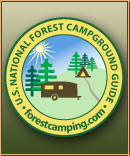Forest Information
The St. Joe National Forest is one of three forests comprising the Idaho Panhandle National Forests. The other two are Kaniksu and Coeur d'Alene National Forests. The St. Joe National Forest is located in northwestern Idaho and is comprised of 868,410 acres. There are 20 developed campgrounds of which 6 meet the selection criteria.
The St. Joe River may appear to be the center piece of the St. Joe National Forest but there is more to this Forest than a single river. A hundred years ago, the lure of land, silver, gold, and lumber brought many to the area. Today, seekers of diverse, quality recreational opportunities and outstanding camping locations are attracted to this little National Forest at the south end of Idaho's Panhandle.
The St. Joe River is a "working" river. In the town of St. Maries, where the river turns north toward Coeur d'Alene Lake, tug boats can be seen pulling rafts or "brailes" of logs to the lumber mills. Known as the world's highest navigable river, St. Joe River attracts many for its whitewater and outstanding fishing. The 120-miles of waterway offers Grade II and III rapids near its headwaters to slow-moving (half-mile per hour) as it approaches Coeur d'Alene Lake, the river has something for everyone.
Several developed campgrounds are located on the St. Joe River. The well-groomed Shadowy St. Joe campground is closest to the town of St. Maries while Fly Flat, at the far end of the river, is the most rustic campground in the forest. Between both are Tin Can Flat and Turner Flat campgrounds. These two little campgrounds can accommodate RV's and motorhomes as well as tent campers. Spend a few hours exploring the nearby town of Avery before relaxing back at your campsite.
Near Pearson Idaho is the western end of the ever-expanding Hiawatha Rail Trail, considered a crown jewel of the Rails to Trails system. This 15 mile trail in the St. Joe National Forest is a must-visit for hikers and mountain biking enthusiasts. Besides the breathtaking views of the surrounding forest and river valley there are nine former train tunnels including the impressive 1.6-mile-long St. Paul Pass Tunnel. It also includes seven high-steel trestles offering stunning elevated scenery and many interpretive signs providing rich historical context about the trail’s origins.
Although there aren't Forest Service maintained hiking trails at the campgrounds along the St. Joe, the fishing is good. Native Cutthroat, Rainbow, and Brook trout, and Mountain whitefish are caught in the St. Joe River. The river also offers whitewater enthusiasts the challenges of Class II and III as well as stretches quiet enough for inner tubes.
Exploring the historic Marble Creek, Emerald Creek Garnet Area, and Hobo Cedar Grove Botanical Area are three "developed" activities found on the St. Joe National Forest. About midway up the St. Joe River Valley, the timbered slopes along Marble Creek have attracted people for a hundred years. Through the efforts of local citizens and the Forest Service, relics illustrating the history of the area's early settlers, homesteading and logging activities are preserved and presented for the visitor. Trails along Forest Route 321 provide access to old logging camps with steam donkeys and other logging equipment adding to the experience.
About 10 miles north of Clarkia, ID or 20 miles south of the St. Joe River, along Forest Route 321, the Hobo Cedar Grove Botanical Area offers the Forest's visitors an excellent interpretative trail through an ancient Cedar grove. The grove is populated by many 500-plus year old Cedars. These trees survived the huge fires of 1910, 1922, 1923, and 1930 and heavy logging of White pines in the area. These grand old monarchs are now the dominate species in the 240-acre tract. Hiking through the grove is magical. The soft carpet of ancient forest soil cushion footsteps, sunlight filters through a lace curtain of cedar bows while chipmunks chatter welcome, and the scent of cedar perfumes the air as it has since before Columbus left Spain in search of China.
The Emerald Creek campground is the most southern developed campground in the St. Joe National Forest. This pretty little campground offers not only a comfortable camping experience for car, tent, RV, and motorhome camping enthusiasts but is also convenient access to the Emerald Creek Garnet area. Open only during the summer months, for a fee, a visitor can hunt all day for Garnet gemstones. Incidentally, the Emerald Creek Garnet Area is the only place, outside of India, where Star Garnets can be found.
The St. Joe National Forest is not a particularly large forest when compared to other National Forests but its size does not limit the variety and number of recreational opportunities offered. Fishing, floating, boating, and camping in the St. Joe River valley, hiking in pristine wildernesses, exploring the area's living history, or experiencing the wonder of finding a perfect garnet dodecahedron crystal are just some of the opportunities that awaits the St. Joe National Forest visitor.
ADDRESSES
SUPERVISOR ADDRESS
3232 West Nursery Rd.
Coeur d'Alene, Idaho 83815
208-765-7223
RANGER DISTRICT ADDRESSES
St. Joe
222 South 7th, Suite #1
St. Maries, Idaho 83861
208-245-2531 |
